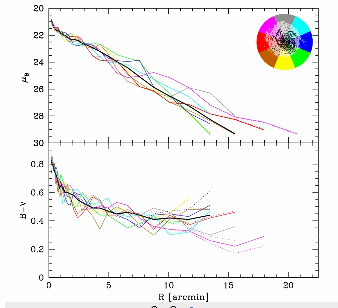Prof Mihos recently used Case's own Burrell Schmidt telescope to
observe the nearby galaxy M101. M101 lives in a small group
environment, and has quite an asymmetric disk, suggesting some
interaction history in its outer regions. The plot below shows the
color gradients for different azimuthal slices of the galaxy,
extending out to large radius (the Burrell Schmidt is one of the best
telescopes in the world for very deep surface photometry). (Click on
the image for a larger version).
Prof Mihos also finds a region in the NE of the galaxy at a radius of 32 kpc with an optical color B-V=0.20. Note that the common astronomical convention is to plot an image with N up and E to the left.
The distance to M101 (from HST Cepheid observations) is 6.85
Mpc. Convert kpc to arcminutes, and work out (by plotting this point
on Mihos' figure) whether this color is consistent with an
extrapolation of the appropriate line on the B-V vs radius plot.
We are going to use the BaSTI population synthesis models to deduce
the age gradient in the M101 disk.
(a) First of all, assume that the whole
galaxy's disk is of solar abundance; in this case the models will
allow us to convert a color directly to an age. Download the
integrated colors for the scaled solar, Z=0.0198 models. Plot B-V
color against age for these models, and plot up the age distribution
of the disk as a function of radius. Graduate students should also
plot the range in age at a given radius for this and the next section.
(b) Now we are going to discard the assumption about the metallicity
of the disk being solar at all radii and use real measurements to constrain the
metallicity gradient in M101. Because M101 is such a well-studied
galaxy, there are also accurate abundance measurements available from
HII regions at a range of radii, from Li et al 2013, shown below (click on image for a larger version).
In order to convert this to metallicity so you can use the propulation
synthesis models, use the solar abundance of Oxygen recommended by
Asplund et al 2009: log (O/H) + 12 = 8.69. It you assume that Oxygen
tracks [Fe/H] throughout the disk (as you are doing by using the
scaled solar models) then this means that [Fe/H] = log (O/H) + 12 -
8.69. Also note that R0=14.4 arcminutes.
For 5 different radii in the galaxy (including its center), work
out the mean abundance from the above plot, then (for undergrads) use
the nearest available population synthesis model or (for graduate
students) interpolate between models to derive the best age for that
B-V color and that metallicity. Compare your answer with the one
using solar abundance for the whole galaxy by plotting the new
metallicity-informed ages on the same plot as the one you made by
assuming the galaxy was all solar metallicity. What you have just
found, called the "age-metallicity degeneracy" is one of the problems
astronomers face when they try to infer the age of a population from a
single color of its integrated light.
Grad students, individual problem: estimate a disk scale length from
the top panel of the first figure, and calculate the total luminosity
of the galaxy disk by integrating the exponential disk. You need to
make an important assumption to be able to do this: what is it?
Compare your value with the tabulated luminosity in the RC3 (Reference
catalog of bright galaxies, 3rd edition).
Then use appropriate assumptions (list and justify them) and the M/L
ratios tabulated in the BaSTI population synthesis models to estimate
the total mass of M101's disk.

